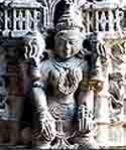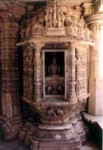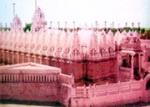Dilwara Temple, Rajasthan
Mount Abu is a famous and only hill station of Rajasthan located in the southwest part of Rajasthan. It is a part of the Aravali range. Mount Abu is separated from Aravali by a narrow valley and Guru Shikhar is the highest point towards the northern end. According to legend, Hindus revere this place because once Nandini, the cow of the sage Vashisht was trapped in a deep gorge and could not free itself.
The sage asked for Lord Shiva's assistance. Shiva sent Saraswati, the divine stream, to help flood the gorge so that the cow could float up.
Sage Vashisht then decided to ensure that such mishaps would not occur in future and asked the youngest son of Himalaya to fill the gorge permanently. He took the help of the snake, Arbud. This spot came to be known as Mount Arbud since then and was later reduced to its present form Mount Abu.
The Dilwara Jain Temple
 A famous and hill station Mount Abu located is located in the southwest part of Rajasthan. The Dilwara Jain temples dedicated to the Jain tirthankars are located 2.5 km away from Mount Abu.They were also storehouses of many rare manuscripts and treatises being constructed around 800-1200 AD. Rajasthan became the centre of architectural marvels in form of temples,forts and palaces.Jain art and architecture flourished under the patronage of Vimala Shah,Vastu and Teja Pala.Built in the Nagara style of temple architecture the earliest temple belong to the same period as Brihadeeswar temple of Thanjur in Tamil Nadu. The inscription at suggests that Jainism made its appearance in the 11th century AD and earlier it was the seat of Shaivism.
A famous and hill station Mount Abu located is located in the southwest part of Rajasthan. The Dilwara Jain temples dedicated to the Jain tirthankars are located 2.5 km away from Mount Abu.They were also storehouses of many rare manuscripts and treatises being constructed around 800-1200 AD. Rajasthan became the centre of architectural marvels in form of temples,forts and palaces.Jain art and architecture flourished under the patronage of Vimala Shah,Vastu and Teja Pala.Built in the Nagara style of temple architecture the earliest temple belong to the same period as Brihadeeswar temple of Thanjur in Tamil Nadu. The inscription at suggests that Jainism made its appearance in the 11th century AD and earlier it was the seat of Shaivism.
The Pittalhar Temple
Build by Bhima Shah a minister of Sultan Begada of Ahmedabad the Pittalhar Temple has a massive metal statue of the Rishab Dev Adinath.It is cast in five metals of which the main metal is 'Pital' (brass), so the name was given 'Pittalhar'. Also known as Shri Rishabh Deoji temple it consist of a garbhagriha, gudh mandap and navchowki.
The Vimala Vashi temple
 On of the On of the earliest and more important of the temples it was built in 1021 AD .It is dedicated to the first Jain Tirthankara, Adinath built by Vimal Shah, minister of a local Rajput ruler, Raja Bim Deo .The open courtyard of the temple is surrounded by 58 cells or kulikas, containing small icons of the image in the main shrine. The length of the temple is 98 ft and the width is 42 ft. Elaborate marble columns surround the main shrine and the front of the cells. A grand hall called the Rang Mandap is supported by 12 decorated pillars. Prithvi Pala, a descendant of Vimal Shah in 1147-49 A.D built the Hastishala or the Elephant Cell .It has a row of elephants sculpture.
On of the On of the earliest and more important of the temples it was built in 1021 AD .It is dedicated to the first Jain Tirthankara, Adinath built by Vimal Shah, minister of a local Rajput ruler, Raja Bim Deo .The open courtyard of the temple is surrounded by 58 cells or kulikas, containing small icons of the image in the main shrine. The length of the temple is 98 ft and the width is 42 ft. Elaborate marble columns surround the main shrine and the front of the cells. A grand hall called the Rang Mandap is supported by 12 decorated pillars. Prithvi Pala, a descendant of Vimal Shah in 1147-49 A.D built the Hastishala or the Elephant Cell .It has a row of elephants sculpture.
The Luna Vashi or the Teja PalaTemple
 Dedicated to the 22nd Dedicated to the 22nd Tirthankara Shri Nemi Nathji the temple resembles the architectural plan of the Vimal Vashi temple .It was built by Vastu Pala and Tej Pala, both ministers of a local ruler, in 1230 AD. It is one of the last monuments built in the Solanki style.Rang mandap has a central dome standing on 8 pillars with a big ornamental and elaborately carved pendent. The huge idol of Naminath is situated in the grabhgraha.
Dedicated to the 22nd Dedicated to the 22nd Tirthankara Shri Nemi Nathji the temple resembles the architectural plan of the Vimal Vashi temple .It was built by Vastu Pala and Tej Pala, both ministers of a local ruler, in 1230 AD. It is one of the last monuments built in the Solanki style.Rang mandap has a central dome standing on 8 pillars with a big ornamental and elaborately carved pendent. The huge idol of Naminath is situated in the grabhgraha.
Parshavanath Temple
Dedicated to Lord Parshavnath it was build by Mandlik and his family in 1458-59 AD. The temple has three storeyed building. There are four big mandaps carved with beautiful sculptures of Dikpals, Vidhyadevis, Yakshinis, Shalabhanjikas and other decorative sculptures in gray sandstone.
Mahaveer Swami Temple
 The Dedicated to the 24th Jain Tirthankara Lord Mahaveer the Mahaveer Swami temple is a small structure constructed in 1582 AD. In 1764 AD Artists from Sirohi decorated the temple with pictures on the upper walls.
The Dedicated to the 24th Jain Tirthankara Lord Mahaveer the Mahaveer Swami temple is a small structure constructed in 1582 AD. In 1764 AD Artists from Sirohi decorated the temple with pictures on the upper walls.
The other tourist attractions in Mt. Abu include the Bikaner Palace, the Nakki Lake, the Adhar Devi temple, Achalgarh Shiva temple and the Gaumukh Shiva temple.
Contribute More Facts